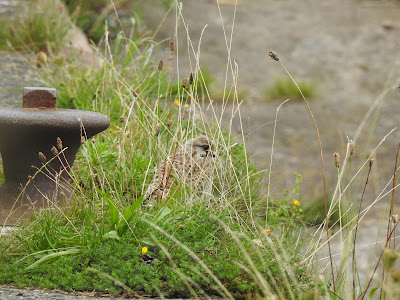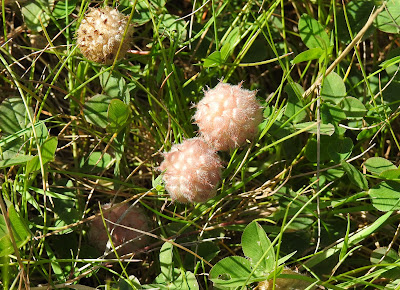I don't want to repeat myself, but it has been another quiet week since I last posted, some eight days ago. We have been out, walking the quay and the riverbank on several occasions, and we even ran our light trap for moths in the garden a couple of times. And this past week I finished with a sea watch from the coastal farm fields, but more of that later.
As I said above, we ran our moth trap twice this last week, and the catches were poor in terms of species, but quite large for us in terms of numbers, thanks to a number of Large Yellow Underwings. We added eight new species for the garden, in the form of Rhomboid tortrix, Acleris hastiana, Copper Underwing, Bird-cherry Ermine, Rosy Rustic, Vine's Rustic, Dark Fruit-tree Tortrix and Garden Rose Tortrix, and incidentally, we just caught one of each of these eight species. Over both days the combined totals of the other moths we caught were, 96 Large Yellow Underwings, four Agriphila geniculeas, a Bright-line Brown-eye, two Lesser Yellow Underwings, a Common Rustic, a Garden Carpet, five Lesser Broad-bordered Yellow Underwings, a Flame Shoulder, and a Setaceous Hebrew Character.
I noticed some larvae were munching my Willows, and after a bit of research I identified them as Lesser Willow Sawfly Nematus pavidus. They aren't rare, in fact they are very common, but it is one of the joys of looking at invertebrates in that virtually everything is new. Well, it is to me anyway!
During the week, Gail and I had a wander along the quay, and along the bank of the River Wyre to Fleetwood. All our visits were mid - late morning, and all our visits were fairly quiet, with the exception of visit number three.
Our first visit was very quiet, even though the southerly wind seemed to give the impression that there might be a migrant or two about, but there wasn't. Looking back at my notebook as I write, it was meagre pickings, and all I will mention is the eighteen Redshanks and fourteen Oystercatchers out on the mud.
For visit number two, the wind had swung round to the northwest, and for some reason, even though it felt a little cooler, a few common butterflies were on the wing. We had seven Small Whites, five Common Blues, two Red Admirals and a Small Tortoiseshell.
Ten Swallows were in the air at one point, alarm calling away, but we couldn't see/find what had upset them. By the way they were behaving, we suspected something mammalian, rather than avian.
Our third visit, which was in fact yesterday, coincided with a falling tide, and we did have a few birds. It was overcast with a chilly north-westerly wind. There were a number of waders feeding in the quay itself, and along the river's edge in the main channel as the tide fell, exposing foraging areas. There were also birds flying downstream. Some stopped off for a few seconds before heading off again, but others just motored past. I've lumped my totals together for all three scenarios, and we had 112 Oystercatchers, 287 Redshanks, a Whimbrel and three Curlews.
As we neared the mouth of the river, we could see onto one of the muscle beds, or scars as they are known, and there were at least 800 Oystercatchers, along with four Little Egrets. This is obviously where all the birds flying downstream were heading.
In addition to the waders heading downstream, we also had 33 Sandwich Terns doing the same. We watched all this activity as we sat on the side of the quay wall overlooking the river. As we were sat watching the natural world go by, a flock of thirty Starlings dropped in just a few metres from us, and they were busy feeding on invertebrates amongst the sparse vegetation along the sea wall. All of a sudden, they were in the air, and a juvenile Kestrel made a very clumsy attempt at catching one, and then perched up on the quay just a few metres from us.
It looked quite comical as it had a bit of a walk about amongst the same vegetation that the Starlings were feeding in. I suspect that if it could have found a large enough invertebrate morsel it would have taken it, but it would have been a poor substitute for a Starling! Whilst we were sat watching the Kestrel, a few Swallows were flying back and forth hawking for insects, and the young Kestrel made a few half-hearted, or poorly executed, attempt of catching a Swallow. The Swallows weren't in any danger!
A male Peregrine was on his usual high tide perch, and now that the tide was dropping, he headed off towards the mouth of the estuary in search of a wader to feed on. On the seaweed encrusted slopes of the sea-wall, Gail spotted a white rump 'bouncing' away, that belonged to a migrant Wheatear. The only other migrant passerine that we had was a juvenile Whitethroat that we encountered on our return leg.
It was a solo outing this morning for me, to the coastal farm fields to have a look over the sea on the in-coming tide. I had 6 oktas cloud cover, with a force 3 - 4 north - westerly wind. Whilst it remained cloudy the visibility was fairly good, but when the clouds cleared a little, there was a heat haze making the visibility not so good.
I'm not sure what I was expecting, but I didn't really expect it to be 'rocking', so when my first bird was a close-in dark morph Arctic Skua heading north, I thought that maybe it might rock a little bit, but it didn't really. There was a supporting cast of 61 Sandwich Terns, 47 Common Scoters, 48 Gannets and a Shelduck, and that was it.
The most unusual birds I had at sea, were a group of five white herons, quite a long way out, heading north. I couldn't make out what they were at all, but I assume that they were Little Egrets. It wasn't a particularly strong north-westerly wind, but they were making slow progress, and I picked them up again a few minutes later and two climbed, and peeled off from the other three, but I couldn't see where they headed.
As the tide ran in, there were a number of Turnstones roosting on the rock armour just off-shore, and I counted 134 in total. The only other waders I had were twelve Oystercatchers and a couple of Sanderlings.
I had a walk round the farm fields and hedgerows after I had finished my sea-watch, and the only migrant I had was a single Whitethroat. A group of fifteen Common Gulls roosting on the front fields with some Black-headed and Herring Gulls is worth mentioning.
I'm not sure why, but I called in at the cemetery on my way home, as I knew there wouldn't be any migrants, but I suppose it's the fact that it is autumn after all, that made me call. And there weren't any migrants!
The weather is looking quite unsettled for the coming week, and I don't know how many blog posts of late that I have ended with that statement! It will be what it will be, and Gail and I will endeavour to make the most of it.


































